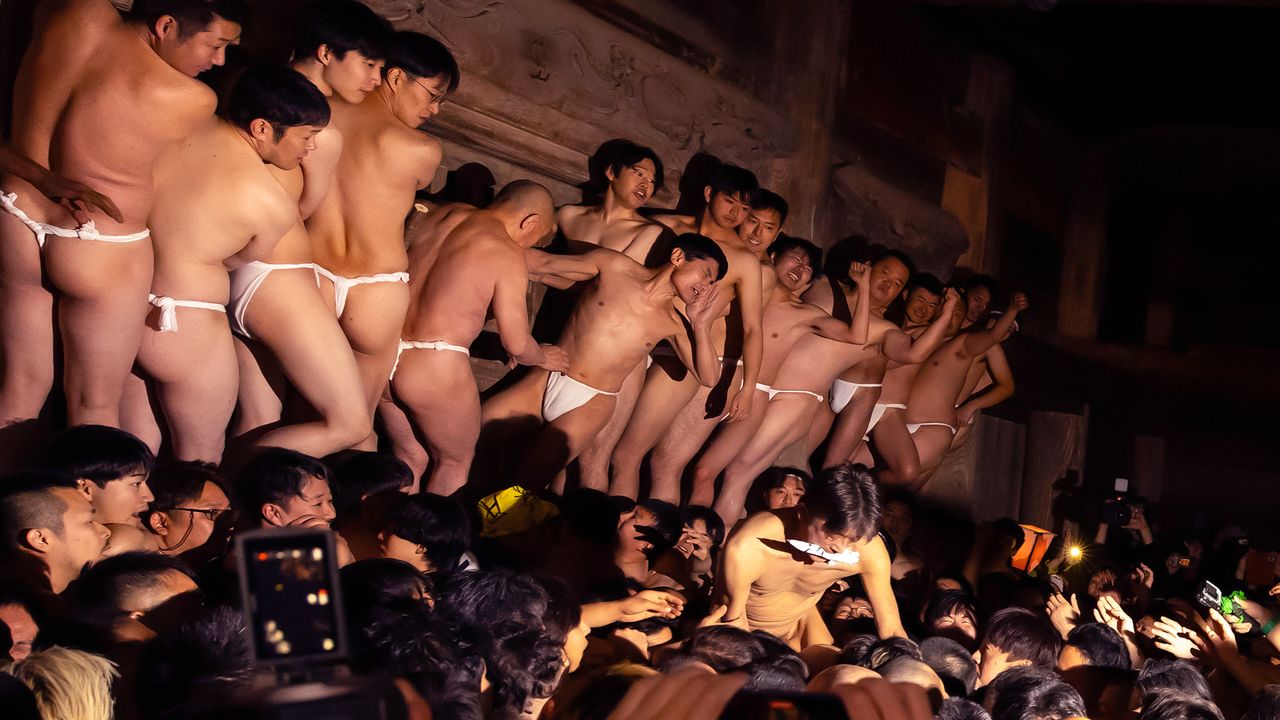
The End of Tradition? Adaptation and Abandonment of Festivals in Japan’s Rural Communities
Culture Society Guide to Japan- English
- 日本語
- 简体字
- 繁體字
- Français
- Español
- العربية
- Русский
Strength for Recovery in Local Festivals
The natural disasters Japan has experienced recently are a timely reminder that Japanese history has never been free from the calamities that the natural world can bring. One reason why Japan has so many spiritual rituals revolving around Shintō gods and Buddhist deities is due to the turn toward the spiritual as people and communities have sought to overcome the trials brought by the many earthquakes, floods, and epidemics that characterize Japanese history.
For example, an indispensable part of summer festivities on the Noto Peninsula in Ishikawa Prefecture is the carrying of kiriko, 15-meter-high lanterns intended to drive away evil spirits. This region was devastated by a New Year’s Day earthquake in 2024, leading some to suggest self-restraint surrounding festivals during the summer months as the disaster’s aftereffects lingered. However, half of the approximately 300 communities that have practiced the kiriko festival for centuries decided to go ahead with events based on the belief that it was precisely the right time to strive to overcome the hardships visited on their communities by the natural world.

Considered one of the most epic of the kiriko festivals, the Kōda Fire Festival took place on July 27, 2024, in Nanao, Ishikawa Prefecture. This is despite the region being one where recovery from the New Year’s Day earthquake has been delayed. (© Haga Library)
Immediately following the Great East Japan Earthquake and tsunami of March 11, 2011, in Tōhoku, various festivals and the various farewell/welcome parties that take place in early April in workplaces across Japan were voluntarily cancelled. However, one month after the disaster, the mayor of Hachinohe, Aomori Prefecture, boldly declared that the Hachinohe Sansha Taisai festival would be held from July 31 to August 4 as it is every year. Focused on the theme of reconstruction, the 2011 festival drew a million people to the Aomori city.
Fukushima Prefecture’s Sōma Nomaoi festival similarly took place following the March 2011 disaster. Many local families saw their horses kept for the festival swallowed up by the tsunami, but the city’s mayor decided that the power of tradition had an important role to play in overcoming adversity. While the 2011 event was delayed until July, focused mainly on the Shintō rituals, and greatly scaled back, the fully revived festival in 2012 saw a massive 160,000 people in attendance and made a major material contribution to regional reconstruction.
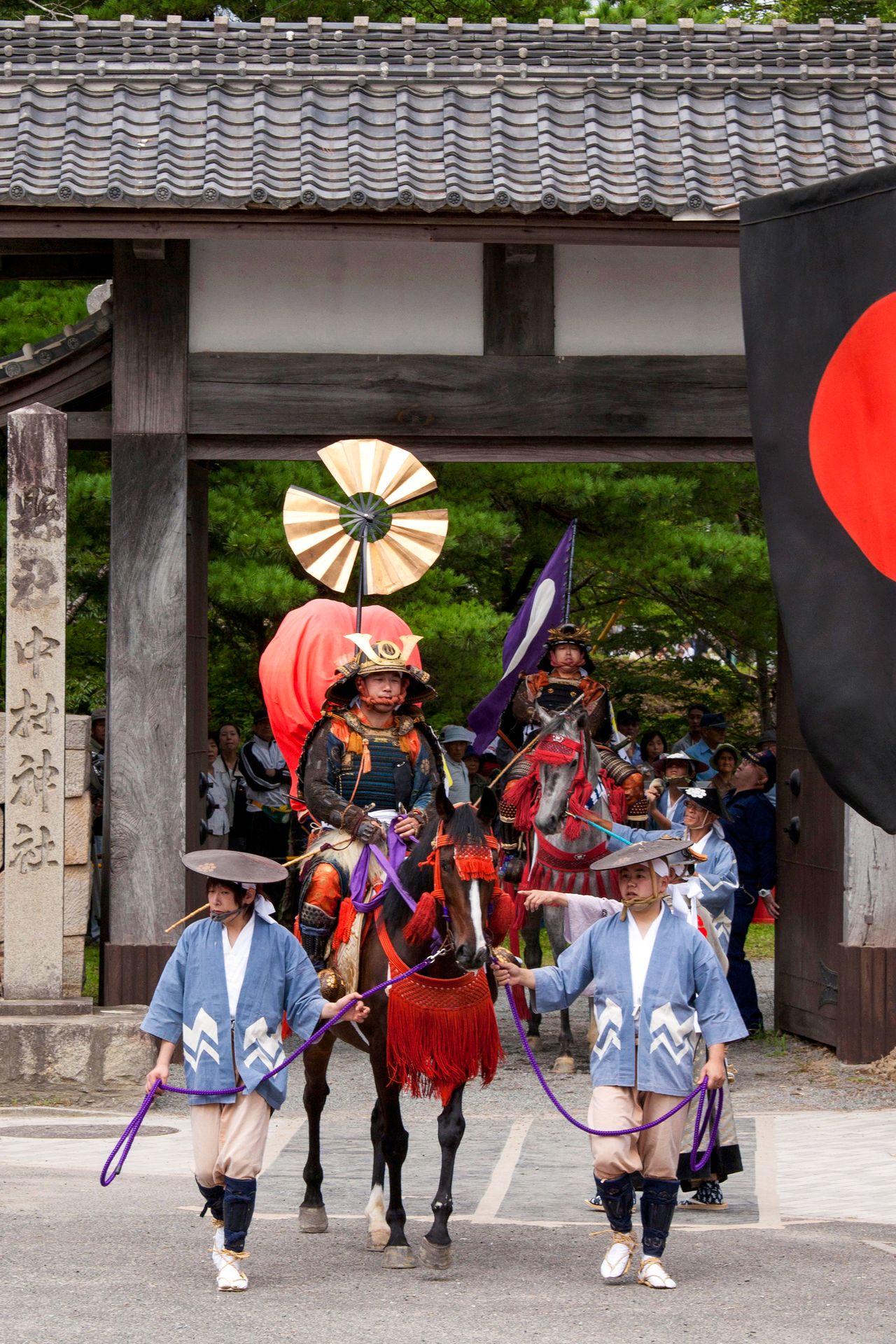
The Sōma Nomaoi festival’s sending-off ceremony on July 23, 2011 (generally held in late May). (© Haga Library)
Iwate Prefecture’s town of Rikuzentakata was devastated by a 17-meter tsunami during the March 11 disaster. Nevertheless, during the traditional Obon summer festival period, the township held its Ugoku Tanabata festival as it normally did. The floats usually used for the festival had been buried in mud by the tsunami, but with the help of 5,000 volunteers, they were restored in time for the festival. The volunteers prayed to their ancestors: “While our town has been washed away, we hope for its return.”
After touring the Tōhoku region, I held a photo exhibition in Tokyo entitled Summer Festivals in the Disaster Areas. At the same time as local people were moved to tears by the images of their disaster-struck hometowns, the images of almost unchanged festival scenes encouraged them greatly, giving them a sense that they had “made a step forward toward recovery” just by being able to hold the festivals. I realized that these events connect people to their hometowns and give them the strength to survive natural calamities.
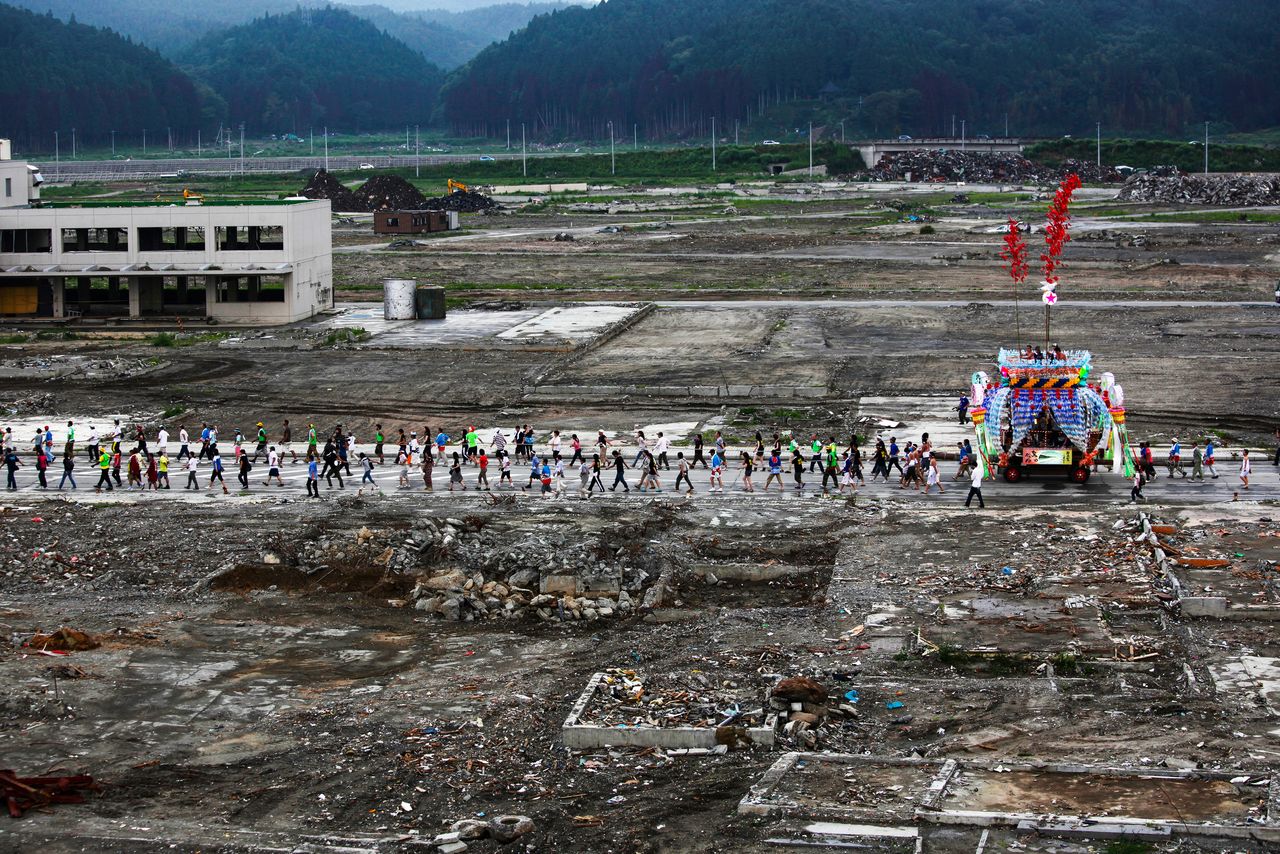
Floats carried through the debris of the Rikuzentakata township during the Ugoku Tanabata festival held on August 6–7, 2011. (© Haga Library)
Pandemic Impact on the Communication of Tradition
The COVID-19 pandemic beginning in 2020 had a different effect. In several cases it severed the community bonds that festivals often strengthen. Gatherings of large amounts of people in one place were avoided during the pandemic, and some events were suspended for the first time in the hundreds of years of their history. Still, some townships were determined to go ahead with tradition, holding their annual events with only residents or event organizers in attendance.
With over 500 years of history, the Shichi festival, held on Iriomote Island in Okinawa Prefecture to welcome visiting deities from the sea, went ahead with strict restrictions on entry to the island during this period. The Ōji Dengaku, a rice-planting dance event held annually at the Ōji Shrine in Kita, Tokyo went ahead with no spectators. The date and time were even hidden from the public, and event organizers and participants disguised themselves as construction workers as they gathered at the shrine.
The city of Fujieda in Shizuoka Prefecture went ahead with the Asahina Dairyūsei, a rocket fireworks display dating back to the Japanese Warring States period of the fifteenth and sixteenth centuries. The event site was blocked off during the pandemic, but it was considered essential to hold the event because the gunpowder technique used is a secret oral tradition meant to be passed on from generation to generation.
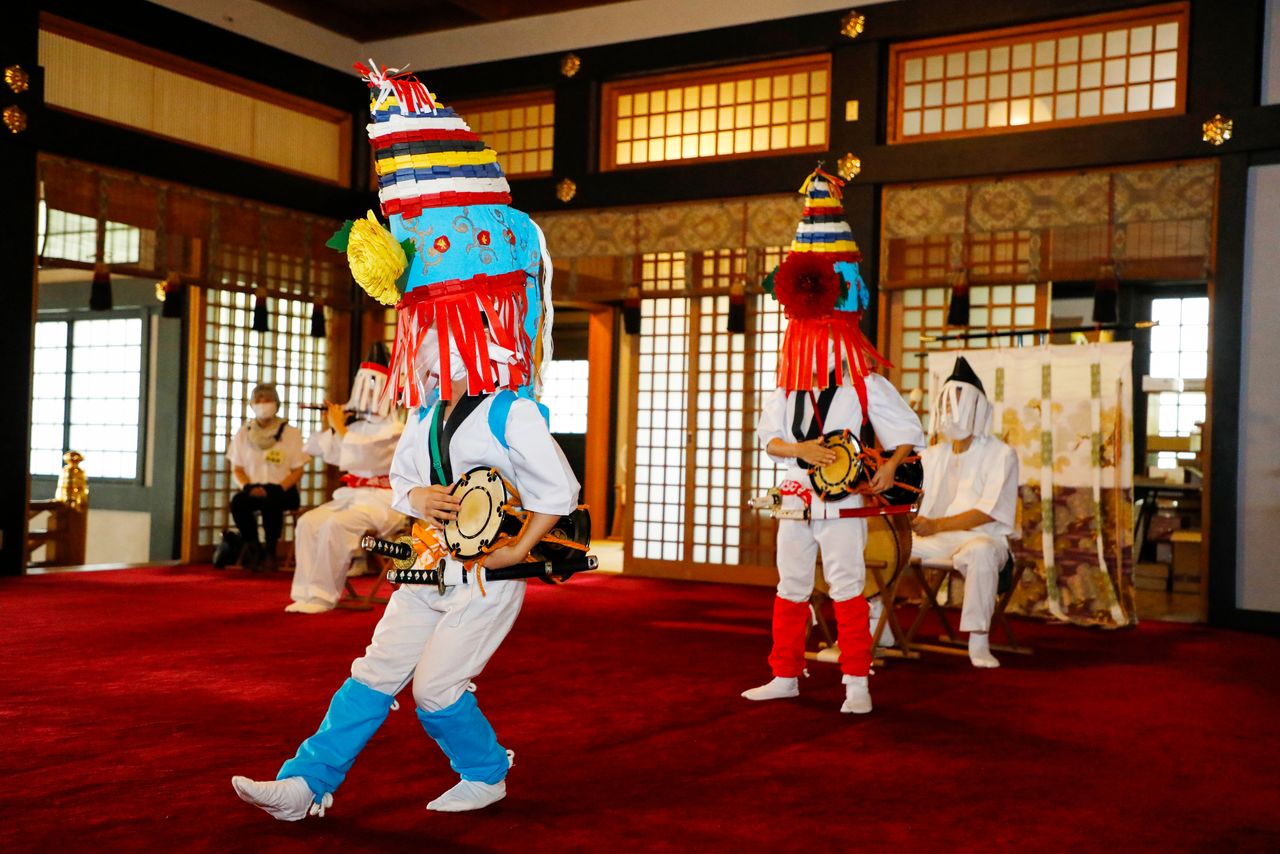
The 2020 Ōji Dengaku was held with no spectators in early August. Indeed, the shrine posted a notice saying it would be cancelled if even one spectator showed up. (© Haga Library)
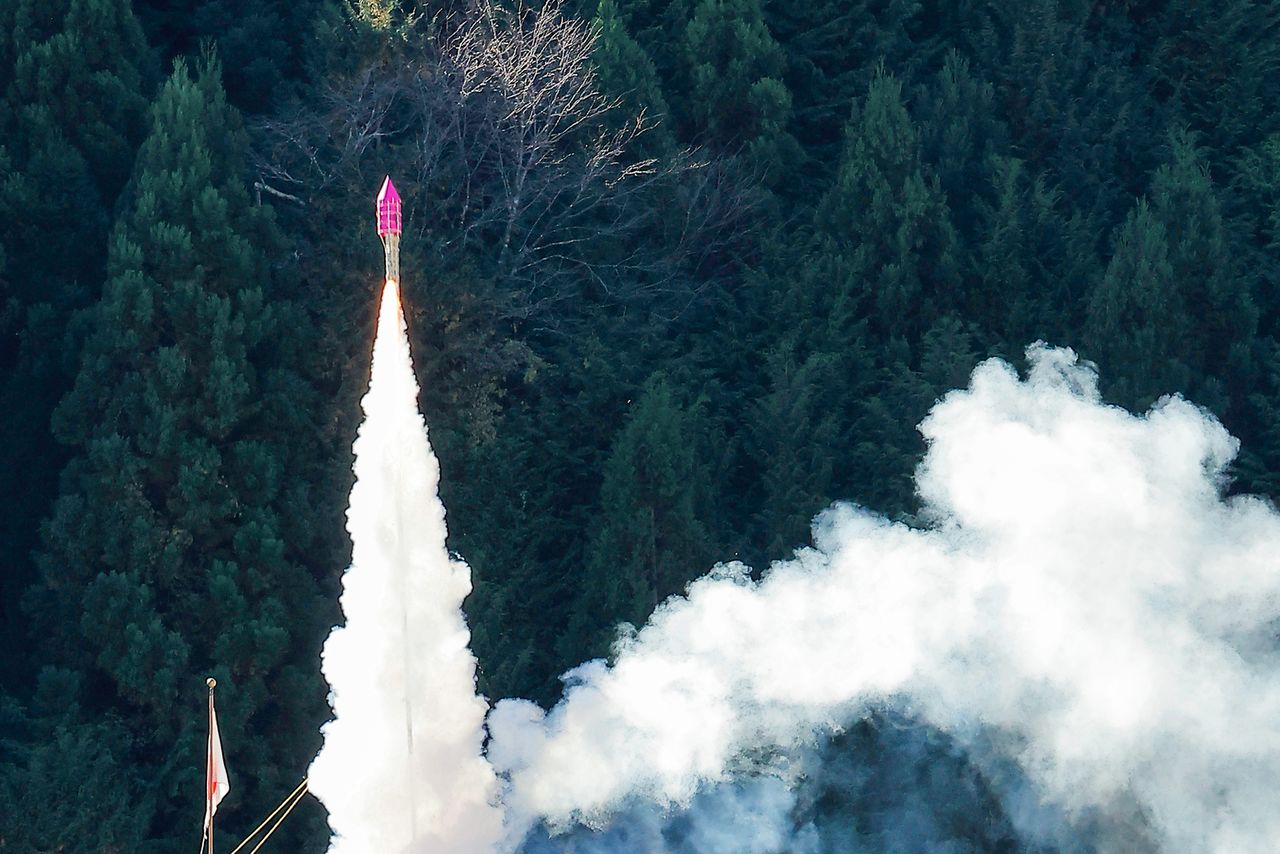
The Asahina Dairyūsei is held in autumn every other year. It was held on November 13, 2021, with no audience. (© Haga Library)
For those events that did not go ahead during the pandemic period, the three-year gap brought into sharp relief issues of survival against the background of declining birthrates, aging populations, and depopulation in Japan’s regions. These issues have made leadership, organization, and the passing down of knowledge about skills and performing arts an issue of urgent attention.
In February 2024, after a break of four years, the Mizusawa-Kuroishi district in Ōshū, Iwate Prefecture, held its latest Sominsai, a “naked festival” at the temple Kokusekiji with over a thousand years of history. This would, however, be the final iteration of this venerable tradition. While the event attracts around 3,000 people—about three times the town’s residents—only about 10 local households of elderly residents organize the festival. In line with tradition, they are required to go into the snowy mountains to cut wood for talismans that are in turn stuffed into the hemp somin sacks that the naked men fight for during the event to bring good luck for the coming year. No longer able to prepare properly, those responsible for organizing the event began to wonder exactly for whom they were continuing the tradition. This is the most famous of Iwate Prefecture’s Sominsai festivals, and other localities close by suffering from similar challenges also took the opportunity to put the tradition to bed.
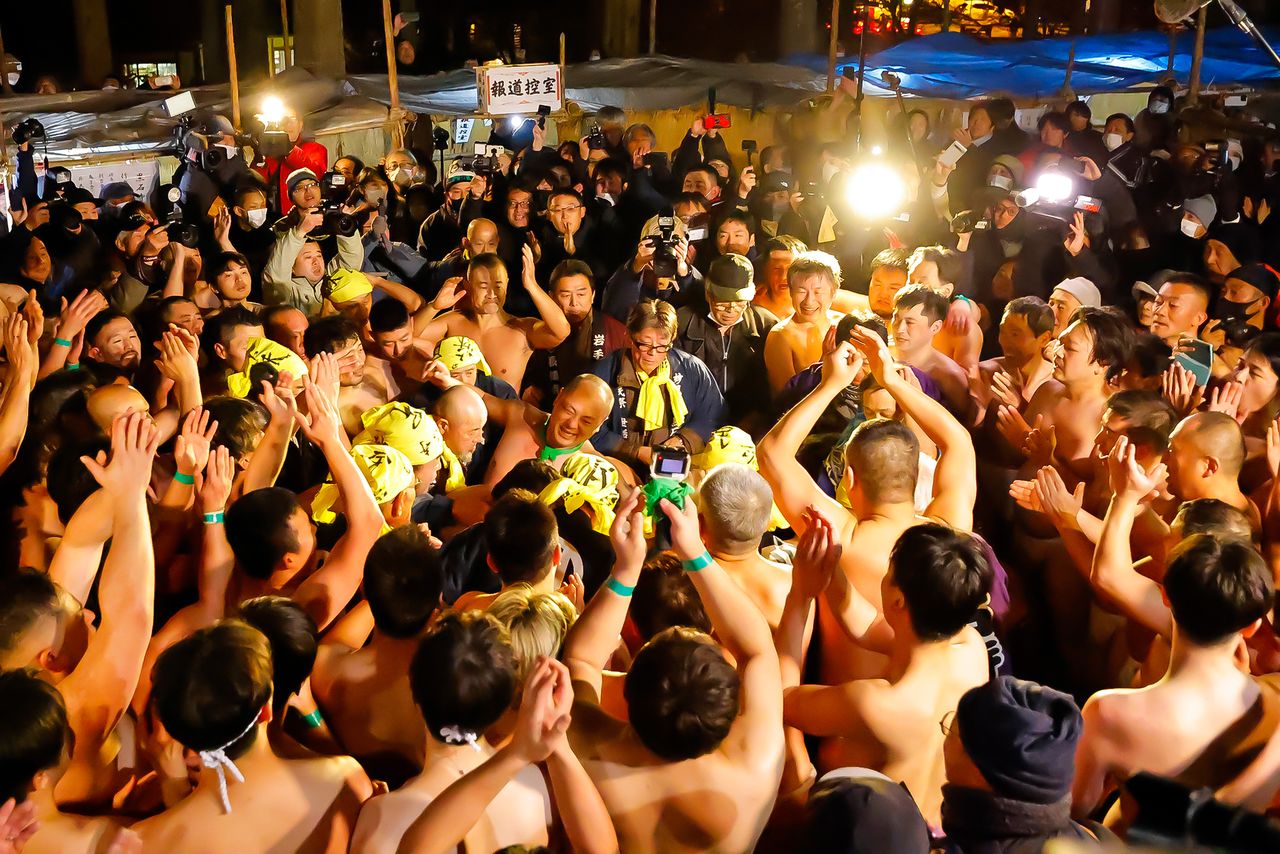
Some 270 naked men and 400 members of the press at the end of the final Sōminsai festival, exceeding the numbers of previous years. (© Haga Library)
There are more than 20,000 communities in Japan where a majority of residents are aged 65 or older. Many of these communities have seen their traditions perish over time. It seems that when there are fewer than 25 households in any locality, there will not be enough people or money to hold a major festival.
There are, however, some communities that have solved the issue of a shortage of organizers and participants. I profile three of these examples below.
Young People Take Over
The first example is one where traditional event organizers and ujiko (shrine parishioners) receive help from outside to continue festival traditions and related events.
For 700 years, the eight districts of Tōyama-gō in Iida, Nagano Prefecture, have held the Shimotsuki Matsuri in November. The festivities include the practice of yudate kagura, with yudate meaning “to boil water” and kagura being a dance dedicated to Shintō gods. The event takes place around the time of the winter solstice, when people dance around a boiling cauldron of hot water to attract the gods and then pour warm water over people to revive their souls following the hardships of winter. Due to serious depopulation in the Kizawa district, around a decade ago the number of ujiko households involved in running the festival fell to only 17. To continue the festival, these pensioners had to contribute ¥100,000 from their own pockets.
Unable to stomach the situation these pensioners found themselves in, young men and women from Tōyama-gō formed the Shimotsuki Matsuri Yarō Kai, an association dedicated to learning the festival customs and dances from the township’s senior citizens to pass on traditions to future generations. In essence, the youth—many who live elsewhere throughout the year—have taken over the organization of the festival as ujiko.
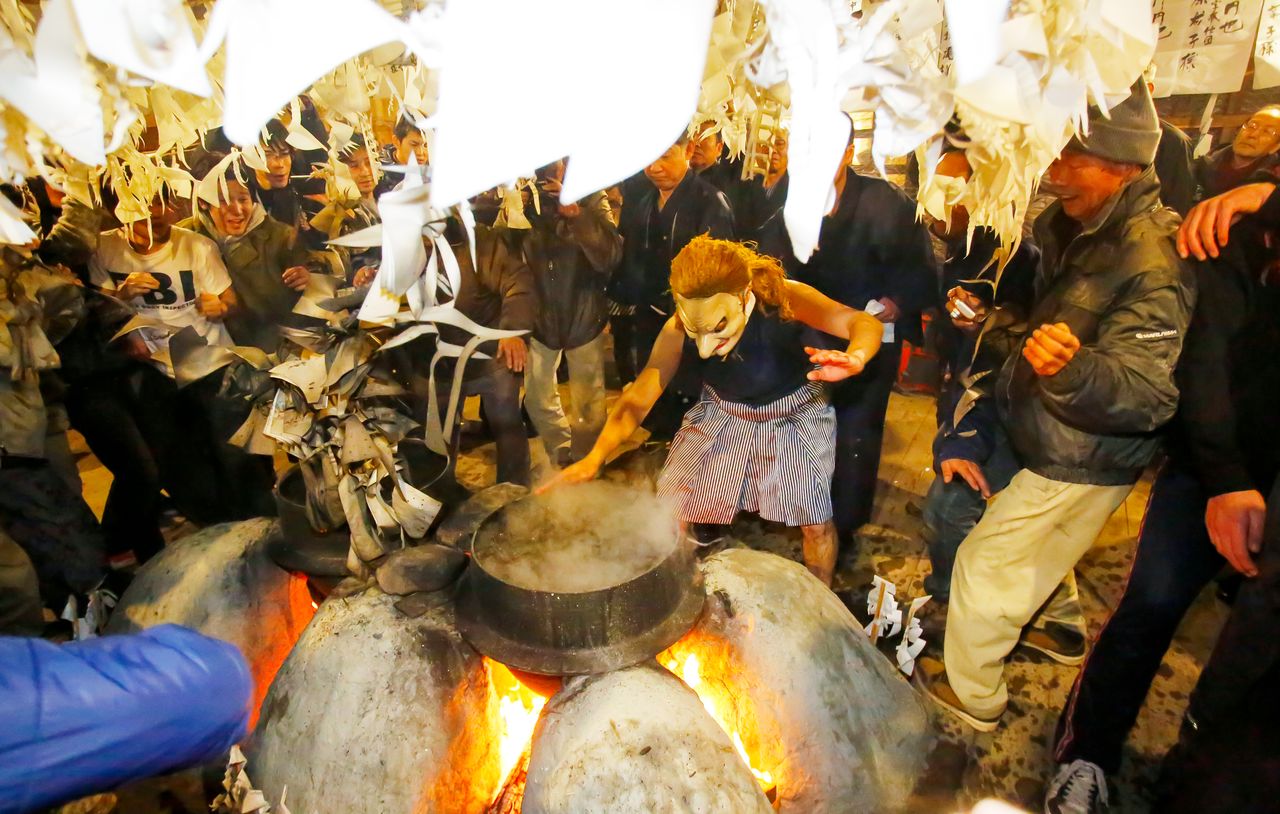
The Shimotsuki Matsuri takes place on the second Saturday in December in the Kizawa district. The leadership of the festival has slowly been transformed by people from their teens through their forties. (© Haga Library)
One of the challenges revolves around the fact that many traditions require the people organizing these festivals to be ujiko, or official shrine parishioners who meet certain criteria. Tōyama-gō has evolved this concept, but some municipalities still cling to the tradition of allowing only ujiko to run the events. Others require festival organizers to be local residents, and in some cases events have been taken over by local governments if this is not viable.
Nevertheless, outside help is one option for preserving traditions. In 2023, Fukuoka Prefecture established a unit dedicated to helping regional communities do just this. This unit will recruit people who want to help or participate in festival organizations and connect them to communities that lack the necessary supporters to sustain their traditional events.
Bringing In Fresh Blood
A second example is one where recent arrivals to a municipality are recruited to take part in organizing traditional events.
For example, the Ichiki District of Kushima, Miyazaki Prefecture, has held a fire festival on the fifteenth day of the eighth lunar month for over 300 years. However, it has struggled for some time with depopulation and an aging community, and the festival almost died out completely.
The solution was found in the surfers who had moved from outside the district to enjoy the waves of the Nichinan coast. These surfers were initially treated as outsiders to the community, but as they increasingly took the initiative, they helped revive the festival. Now known as the Ichiki Koshiki Jūgoya Hashiramatsu Shinji, the main event of this festival of lights is when burning straw is thrown into baskets at the end of pine pillars and raised to create a light effect. The refreshed festival not only continues an ancient tradition but has facilitated the integration of “outsiders” into the community itself.
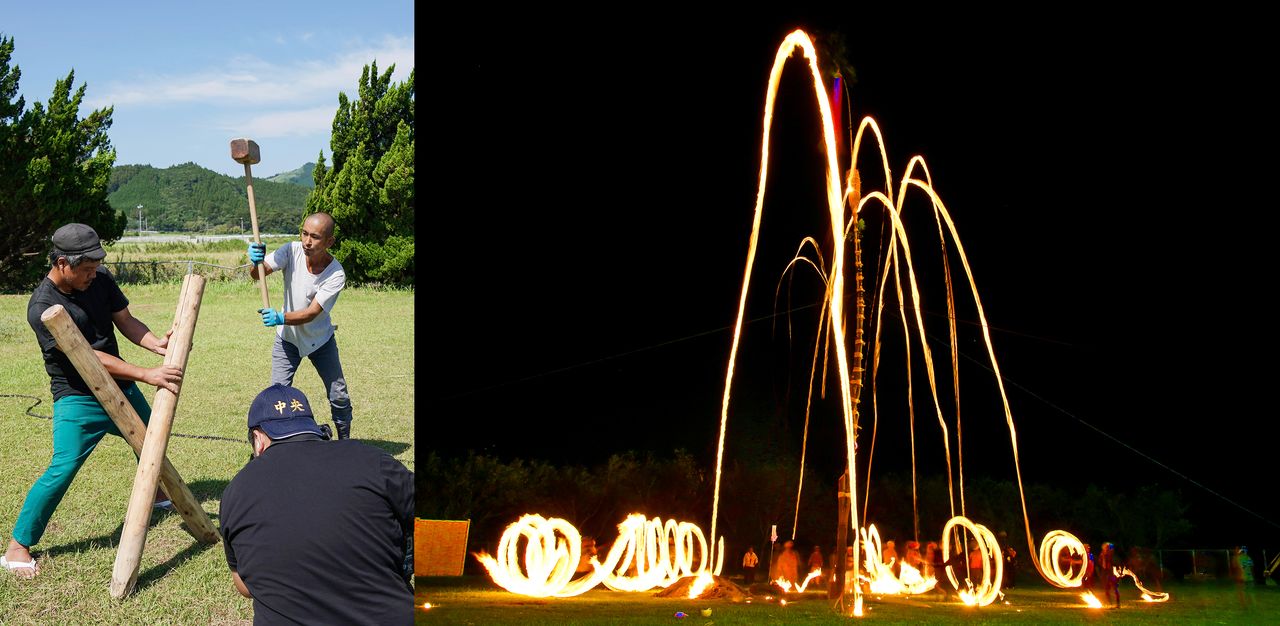
Scenes from the Ichiki Koshiki Jūgoya Hashiramatsu Shinji, literally the “Ichiki traditional-style pine pillar festival on the fifteenth evening.” (© Haga Library)
Increased Participation of Women and Girls
The third example is where a festival expands participation by breaking down traditional cultural barriers between men and women.
The Hana Matsuri of the 14 districts in the Okumikawa region of Aichi Prefecture is another yudate kagura festival. Passed down generations for over 700 years, the festival begins at midnight with a hana no mai, or flower dance, performed by chigo or children designated to have descended from the gods. In festival tradition throughout Japan, this is generally limited to boys under 10 years old. Furthermore, in hana no mai rituals, participation is often limited to the eldest sons of families that live locally.
However, in the Misono district of Tōei, Aichi, there are only 34 households. Already for 20 years, children from outside the community have been allowed to participate in festival events. Not long after this change was made, the region saw the first children to be born in Misono for more than a decade—twin girls. At the age of four, the twins made their debut as chigo and attracted the attention of spectators as if they were idols. These days, the hana no mai dance is a fully integrated mixed-gender event.
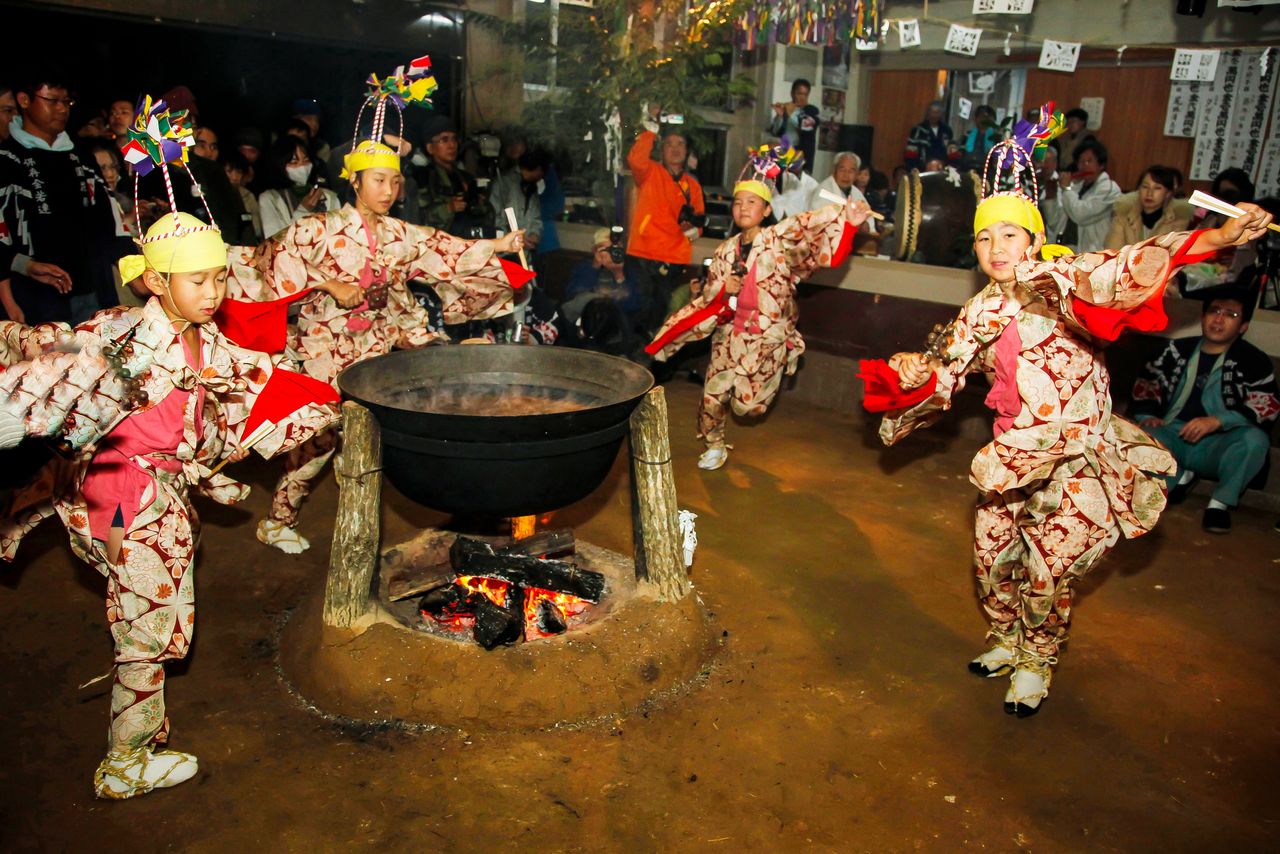
The dances performed by chigo around hot water at flower festival in the Okumikawa region of Aichi Prefecure usually take place from November to January. (© Haga Library)
The traditional Kashima no Kaineri oar parade in the Hōjō district of Matsuyama, Ehime Prefecture, can be traced back to the victory prayers for the victory of naval/pirate forces that operated in the Seto Inland Sea near the end of the Heian period (794–1185). Because it is a festival for men of the sea, the role of the oar-wielders in the procession who dance at the bow of the boat has traditionally been restricted to boys of ujiko families.
In 2023, however, the event was in danger of being suspended due to a lack of eligible participants. After much deliberation, the festival chairman reluctantly decided to make a major change in tradition and setting a new precedent by allowing his two daughters to participate. The girls danced again the following year, thrilling the audience in the process.

Scenes from on the sea during the Kashima Oar Parade, generally held May 3–4. (© Haga Library)
Not all festivals and rituals have been opened to women, however. For example, the sumō ritual held at Nagasaki City’s Hachiman Shrine in Takahama, Nagasaki, during the Shūki Taisai (Autumn Grand Festival) has been held for over 200 years. It begins with ritual sumō matches by elementary-school-aged and younger boys. However, in 2018, event organizers could not find enough boys to participate in the ritual part of the festival. While girls can participate in the sumō matches after the ritual, the Takahama Sumō Association deliberated about the participation of girls in the ritual as well—eventually coming to the decision that it was still “not the right time” to consider the participation of girls. It decided to reduce the number of boys needed instead.

Girls take part in sumō matches outside the main ring during the Takahama Hachiman Shrine Shūki Taisai. (© Haga Library)
In their own ways, all of these communities are struggling with the challenge of ensuring the survival of their customs while still respecting their ancestors and the heritage handed down from generation to generation. Whether by adapting or holding to these traditions, I hope as many festivals as possible will remain for people to enjoy and contribute to the sustenance and even revitalization of Japan’s regions.
(Originally published in Japanese. Banner photo: The battle for the somin sacks at the final Sominsai festival at the temple Kokusekiji in Ōshū, Iwate Prefecture, February 17, 2024. Festival dates are based on schedules from past years. © Haga Library.)
